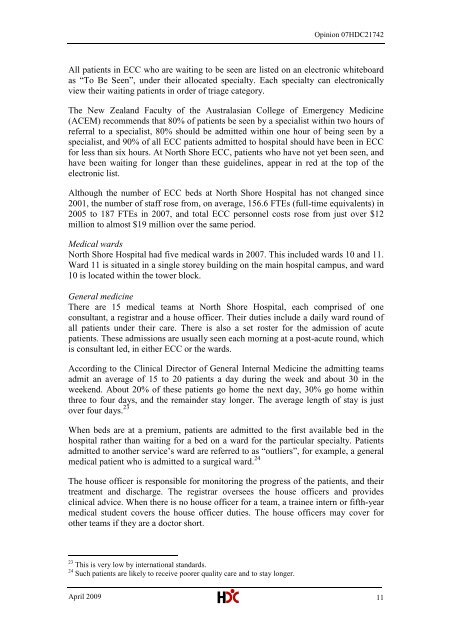North Shore Hospital report - New Zealand Doctor
North Shore Hospital report - New Zealand Doctor
North Shore Hospital report - New Zealand Doctor
You also want an ePaper? Increase the reach of your titles
YUMPU automatically turns print PDFs into web optimized ePapers that Google loves.
Opinion 07HDC21742All patients in ECC who are waiting to be seen are listed on an electronic whiteboardas ―To Be Seen‖, under their allocated specialty. Each specialty can electronicallyview their waiting patients in order of triage category.The <strong>New</strong> <strong>Zealand</strong> Faculty of the Australasian College of Emergency Medicine(ACEM) recommends that 80% of patients be seen by a specialist within two hours ofreferral to a specialist, 80% should be admitted within one hour of being seen by aspecialist, and 90% of all ECC patients admitted to hospital should have been in ECCfor less than six hours. At <strong>North</strong> <strong>Shore</strong> ECC, patients who have not yet been seen, andhave been waiting for longer than these guidelines, appear in red at the top of theelectronic list.Although the number of ECC beds at <strong>North</strong> <strong>Shore</strong> <strong>Hospital</strong> has not changed since2001, the number of staff rose from, on average, 156.6 FTEs (full-time equivalents) in2005 to 187 FTEs in 2007, and total ECC personnel costs rose from just over $12million to almost $19 million over the same period.Medical wards<strong>North</strong> <strong>Shore</strong> <strong>Hospital</strong> had five medical wards in 2007. This included wards 10 and 11.Ward 11 is situated in a single storey building on the main hospital campus, and ward10 is located within the tower block.General medicineThere are 15 medical teams at <strong>North</strong> <strong>Shore</strong> <strong>Hospital</strong>, each comprised of oneconsultant, a registrar and a house officer. Their duties include a daily ward round ofall patients under their care. There is also a set roster for the admission of acutepatients. These admissions are usually seen each morning at a post-acute round, whichis consultant led, in either ECC or the wards.According to the Clinical Director of General Internal Medicine the admitting teamsadmit an average of 15 to 20 patients a day during the week and about 30 in theweekend. About 20% of these patients go home the next day, 30% go home withinthree to four days, and the remainder stay longer. The average length of stay is justover four days. 23When beds are at a premium, patients are admitted to the first available bed in thehospital rather than waiting for a bed on a ward for the particular specialty. Patientsadmitted to another service‘s ward are referred to as ―outliers‖, for example, a generalmedical patient who is admitted to a surgical ward. 24The house officer is responsible for monitoring the progress of the patients, and theirtreatment and discharge. The registrar oversees the house officers and providesclinical advice. When there is no house officer for a team, a trainee intern or fifth-yearmedical student covers the house officer duties. The house officers may cover forother teams if they are a doctor short.23 This is very low by international standards.24 Such patients are likely to receive poorer quality care and to stay longer.April 2009 11
















